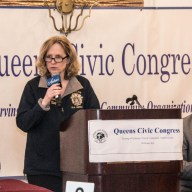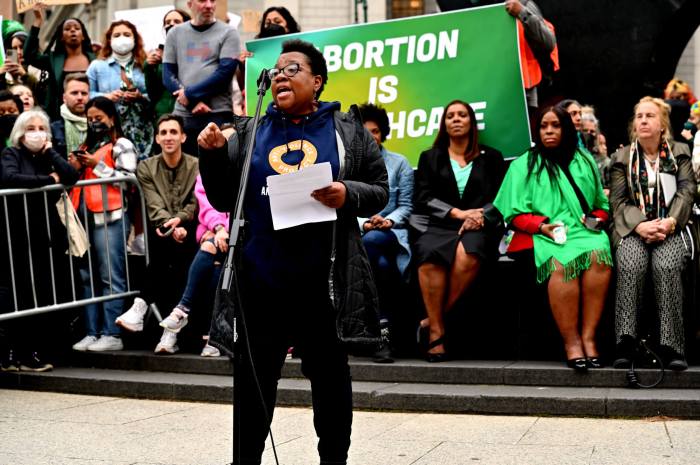By Dara Pettinelli
It is a world where people greet each other with handshakes and kisses, where ladies wrap themselves in fur coats and hats, where young girls show off their trendiest handbag and designer jeans and where most designers prefer wearing all black.It's a culture in which the words “chic” and “delicious” describe clothes and people alike. It's home to corporate sponsors pushing their product in little kiosks inside the reception area, stuffing free samples into 'cute' gift bags, offering temptation with every freebie. Security guards with ear mics and publicists with seating charts act as gatekeepers to the masses.In this world, the celebrities are gods, designers the divine inspiration and photographers the worshipers. And the attendees – they are the chosen disciples of fashion, lining up behind the ropes, invitations in tow, waiting to fill the pews in the house of worship. This is the world in which designer and Astoria native Joanna Mastroianni made her runway debut.Mastroianni started designing dresses for her dolls at 4 years old. Every week Mastroianni visited a neighborhood seamstress who gave her fabric samples and scissors to play with. She took these fabrics home and determined what cut would look best on her first models. “I had total clarity that fashion was going to be a way of life for me,” said Mastroianni. “I had a subscription to Vogue at 9 years old.” From there, Mastroianni went on to graduate from the Fashion Institute of Technology and the Parsons School of Design; art and fashion always the focus of her studies. On the lookout for new talent, Henri Bendel's purchased some of Mastroianni's creations while she was a still a student. Bergdorf Goodmans came next and the interest in her work kept growing. Her dresses have appeared on celebrities such as Sharon Stone, Angela Bassett and Melanie Griffith at world-renowned events including the Academy Awards, the Tonys and the Grammys.Now, at age 46, Mastroianni desgins creations that are sold at more than 40 high-end stores across the country, including Saks Fifth Avenue and Neiman Marcus. Her dresses cost anywhere from $4,500 to $14,000, depending on the style and fabrics used. She welcomes appointment-only clientele into her own salon and workspace in Manhattan, where she now lives with her husband and son. Yet, despite all the recognition from buyers and celebrities, Mastroianni had not launched a runway show until last week, when she saw her creations paraded down the catwalk for the first time Friday, the eighth and final day of Fashion Week.”You're afraid to sit down and you're afraid to eat,” Mastroianni said of her feelings leading up to her runway debut. “You're running faster than a train and you just don't stop.” Mastroianni started her day at 5 a.m. on two hours of sleep. She first went into her shop for some last-minute fitting, pinning, tucking and finishing of the garments before they were packed and brought to the tents at Bryant Park at 8 a.m. Once she arrived on location around 9 a.m., she tracked down models who were late, made sure that all 40 garments arrived, that all 15 hairstylists and 15 makeup artists were ready to go and she oversaw the producers testing the music, lights, and camera arrangements. In between the frenzy and anxiety of overseeing every detail, Mastroianni gave interviews to newspapers, magazines and television shows. “You feel dizzy,” she said, “but you have to keep going.” A diet of coffee and water kept her moving through the chaos. And then it was show time. More than 500 guests filled the Atelier tent at a little after noon. Ralph Lauren revealed his Fall 2005 Collection in the same tent an hour before Mastroianni's creations graced the stage. The tent was so crowded for her show, she said, that security had to stop admitting people who were trying to wiggle their way in at the last minute. This was the largest crowd she ever presented her work to, Mastroianni said. These 500 or so people included retail buyers, editors and other news media, friends, fashion lovers and paparazzi. But how does a first-time runway designer attract so much attention in the same venue that hosts big names like Oscar de la Renta, Carolina Herrera and Diane von Furstenberg? According to Isabelle Kellogg, luxury products editor for Cottages & Gardens Publications, new designers keep it real. Fashion Week has become so corporate and celebrity focused, that the art and innovation of the designs are lost in the mix, she said. Thus, people attending the shows of up-and-coming designers are “hopefully there to see what fashion is all about,” said Kellogg. And what Mastroianni's audience witnessed in 20 minutes was genuine design. Nothing was avant-garde or over-the-top. Inspired by the Art Deco period of the 30's and 40's, sleek lines and chiffon layers added a romance to Mastroianni's creations. Architecture also played a part in the collection. French artist Edgar Brandt, who designed doors, gates and staircases, was evoked in embroidered swirls and circles and beading in the skirts, dresses and clutch bags. Luxurious materials provided graceful movement down the runway. “Chic is her thing,” said Kellogg, “These are dresses you would buy if you had the money.”Timeless elegance defined Mastroianni's Fall 2005 Collection. Black patent leather and fur trim accessorized two-piece skirt and sweater sets that primarily stayed within the color palette of brown, tan, camel, black and white. Cashmere sweaters, silk dresses, chenille and mohair jackets proclaimedMastroianni's love of luxurious fabrics, which are imported from Europe. Splashes of turquoise, yellow and fuchsia in cocoon jackets brought fitted black, floor length skirts to life. The dresses were definitely the highlight of the collection. From pantsuits and cocktail dresses to evening gowns, Mastroianni blended the finest material into the most refined designs. A long, black matte jersey dress with a plunging V-neck and white, beaded lace straps was glamorous while simplistic in design and stayed in the memory of onlookers. “I loved the black and white dresses,” said Lexi Welk, public relations manager at the clothing company Sigrid Olsen, after the show. “They are great for today's Academy Awards.” Backstage after the show, a cluster of fans encircled the designer waiting to congratulate her. Some had already put in requests and made appointments to visit Mastroianni's shop. Prospective buyers will review the collection again and place their orders in a couple of weeks. “I think it went well, I'm happy and relieved it's over,” Mastroianni said between handshakes and kisses. To pull off a show like this, Mastroianni worked 14- to 16-hour days, six days a week for three months. “What you are seeing for 20 minutes is easily three months of work,” she said. In addition to picking fabrics and designing a collection, models and stylists have to be hired, sponsors have to be secured and invitations have to be sent. Running a show at Fashion Week can cost up to $250,000 or more, so preparing for it both financially and creatively is a huge responsibility, she said. “It's a big commitment on many levels, you need to know if you're ready to handle it,” said Mastroianni. “It's really preparing yourself to the next level.” Now that she's reached the level of runway designer, Mastroianni dreams of reaching the masses with causal wear, children's wear, home design, and fragrances. But before she takes over the design world, Mastroianni will go to Europe in a couple of weeks to buy fabrics for her Spring 2006 Collection. “On one level you're relieved you got the job done and this is months of work that's right in front of your eyes and completes itself in 15-20 minutes,” she said. “And on another level, you miss that process of innovation and discovery – but then you know there will be another one.”On Friday night she celebrated for the first time all week at a party with Elite Models in downtown Manhattan.”Maybe before that I can sleep for 20 minutes,” she said.After all, Rome wasn't built in a day.






























